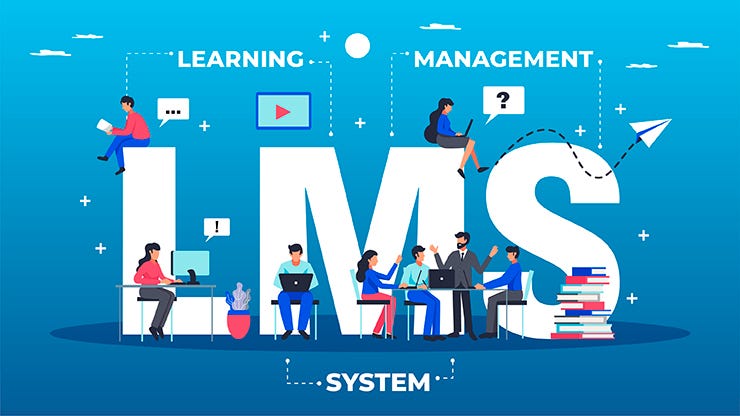Learning Management System (LMS)
The goal of a Learning Management System (LMS) is to provide a centralized platform for efficient course administration, personalized learning experiences, collaboration, tracking learner progress, generating insights through analytics, and facilitating compliance training.

Students are provided with a unique ID for proper access to the LMS software, where they can readily access course details within their program. This complete online learning software offers a wealth of information,
including details on various courses, exam schedules, transcripts, timetables, department contact numbers, and email programs.
The prime users of this learning management software are learners, and their personal details can be seamlessly saved by integrating it with other systems. Implementation of the best LMS software, students enjoy the flexibility to complete their courses from anywhere, at any time, without being constrained by geographical or time limitations.
The prime users of this learning management software are learners, and their personal details can be seamlessly saved by integrating it with other systems. Implementation of the best LMS software, students enjoy the flexibility to complete their courses from anywhere, at any time, without being constrained by geographical or time limitations.
In this LMS software, the course management module covers various means such as PDFs, word documents, etc. The admin can embed YouTube videos or mp3/mp4 files into the LMS software. It further consists of quizzes and
discussion portals which will help to gauge student capabilities. Also, the students can have access to the certificates which they can download after the course completion.
The Reporting module within the Learning Management System for Students compiles comprehensive reports detailing a student's progress in course completion and their course activity data. These reports are seamlessly generated within the module, allowing students to access them and gain valuable insights into their strengths and the areas need to improve within particular topics.
The Reporting module within the Learning Management System for Students compiles comprehensive reports detailing a student's progress in course completion and their course activity data. These reports are seamlessly generated within the module, allowing students to access them and gain valuable insights into their strengths and the areas need to improve within particular topics.
The learning management software helps the institute to create syllabus and lecture-wise teaching plans in order to finish the course on time and meet the overall goals of an institute.
It further helps in creating various portions of the syllabus in compliance with the institutional policies. The faculty can see the listing of upcoming and current class programmes which can be updated accordingly.
Moreover, with the help of LMS software, the teachers can design and assign teaching plans which can later be viewed, activated, edited, or modified with mere clicks. Also, the faculty can upload notes, teaching materials, case studies, worksheets, and documents to each lesson.
Moreover, with the help of LMS software, the teachers can design and assign teaching plans which can later be viewed, activated, edited, or modified with mere clicks. Also, the faculty can upload notes, teaching materials, case studies, worksheets, and documents to each lesson.
With the integration of the LMS software, faculty members can constantly upload course materials in a range of formats, including text files, Word documents, audio and video files, presentations, and more. This triggers automated notifications
to inform students about new uploads, enabling them to access their course content within their accounts and download the relevant files from the online learning software.
Teachers can plan the timetable and create new content accordingly to be uploaded on the portal. The learning management software further allows the educators to create a course from scratch. They can name individual sections and drag & drop content once created or sourced externally
Teachers can plan the timetable and create new content accordingly to be uploaded on the portal. The learning management software further allows the educators to create a course from scratch. They can name individual sections and drag & drop content once created or sourced externally
By leveraging the capabilities of the best LMS software by integrating with Microsoft Teams, we facilitate superior collaboration between teachers and students, ensuring a continuous flow of learning resources.
Microsoft Teams, known for its chat-based functionality, streamlines document sharing, enables online meetings, and keeps calendars up-to-date. This creates a seamless learning experience for students,
allowing them to maintain constant communication with peers and instructors. Moreover, the online learning software seamlessly digitizes teaching sessions, contributing to enhanced productivity.
The Learning Management System for Students is seamlessly integrated with MS Teams, allowing faculty to invite students to their online lectures with a simple click on the shared link to join the session. Within this platform, students learn to actively engage, connect, and communicate within the group for posts and assignments. Furthermore, through community learning, students can collaborate on the same document simultaneously, simulating the experience of having a discussion in a traditional classroom setting.
The Learning Management System for Students is seamlessly integrated with MS Teams, allowing faculty to invite students to their online lectures with a simple click on the shared link to join the session. Within this platform, students learn to actively engage, connect, and communicate within the group for posts and assignments. Furthermore, through community learning, students can collaborate on the same document simultaneously, simulating the experience of having a discussion in a traditional classroom setting.
The LMS software's assignment functionality empowers students to submit their tasks promptly in an online format. It provides a designated space for each student to present their assignment, accommodating both individual and group submissions. Students can conveniently upload various file types and share links.
This feature simplifies the process for teachers to receive and efficiently grade assignments, minimizing any administrative challenges.
Additionally, within the LMS software, assignments can be scheduled for various course sections. These assignment schedule dates can be determined based on the rules set by teachers. Educators have the flexibility to create and oversee assignments tailored to individual students, entire classes, or groups, utilizing specific filter options. Furthermore, they can establish due dates and configure submission types, whether online or offline. The learning management software also enables teachers to align assignment questions with specific course outcomes and categories of Bloom’s Taxonomy
Additionally, within the LMS software, assignments can be scheduled for various course sections. These assignment schedule dates can be determined based on the rules set by teachers. Educators have the flexibility to create and oversee assignments tailored to individual students, entire classes, or groups, utilizing specific filter options. Furthermore, they can establish due dates and configure submission types, whether online or offline. The learning management software also enables teachers to align assignment questions with specific course outcomes and categories of Bloom’s Taxonomy
Our LMS software is in-built with live chat and mailing functionality which allows instructors to create an engaging and creative learning environment. The chat feature improves student’s participation by directly communicating with learners in real-time.
Also, group chats or projects can be adopted to help learners by allowing them to actively participate in various brainstorming sessions.
MCQs, Descriptive Tests, OTP-based tests can be integrated with the LMS software as well question banks can be created, thus simplifying the student’s learning journey. Special online tests can be conducted in the form of electronic submission forms and computerized
adaptive & classification testing. Electronic marking accommodates written, multiple choice, and video submission types of exams. Also, the learning management system for students offers different kinds of quizzes for students that are further equipped with advanced tracking and reporting features, thus providing detailed MIS reports.
Teacher-Student Discussion Forum
The learning management software adopts asynchronous discussion forums to promote interaction between students and teachers.
These forums allow instructors to intervene in student learning activities while giving students a platform to think and give answers at their
own pace. The forum further acts as a tool to promote reflection on learning, share information on various topics, and connect students.
It further offers students the opportunity to pick the topic and participate in debate with their peers. Moreover, learners can easily ask queries to the faculty and get answers quickly in the forums by discussing it with other mates.
own pace. The forum further acts as a tool to promote reflection on learning, share information on various topics, and connect students.
It further offers students the opportunity to pick the topic and participate in debate with their peers. Moreover, learners can easily ask queries to the faculty and get answers quickly in the forums by discussing it with other mates.




